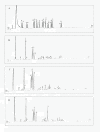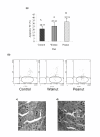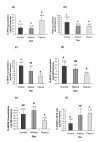Effect of ω-3 and ω-9 fatty acid rich oils on lipoxygenases and cyclooxygenases enzymes and on the growth of a mammary adenocarcinoma model
- PMID: 20932327
- PMCID: PMC2959203
- DOI: 10.1186/1476-511X-9-112
Effect of ω-3 and ω-9 fatty acid rich oils on lipoxygenases and cyclooxygenases enzymes and on the growth of a mammary adenocarcinoma model
Abstract
Background: Nutritional factors play a major role in cancer initiation and development. Dietary polyunsaturated fatty acids (PUFAs) have the ability to induce modifications in the activity of lipoxygenase (LOX) and cyclooxygenase (COX) enzymes that affect tumour growth. We studied the effect of two diets enriched in 6% Walnut and Peanut oils that are rich in ω-3 and ω9 PUFAs respectively on a murine mammary gland adenocarcinoma as compared with the control (C) that received commercial diet.
Results: Peanut oil enriched diet induced an increase in membrane arachidonic acid (AA) content and the cyclooxygenase enzyme derived 12-HHT (p < 0.05) and simultaneously showed decrease in 12-LOX, 15-LOX-2, 15-LOX-1 and PGE activities (p < 0.05) that corresponded to higher apoptosis and lower mitosis seen in this group (p < 0.05). Furthermore, Peanut oil group showed lower T-cell infiltration (p < 0.05), number of metastasis (p < 0.05) and tumour volume (p < 0.05) and longer survival rate compared to other groups.
Conclusions: The results of the present study showed that Peanut oil-enriched diet protects against mammary cancer development by modulating tumour membrane fatty acids composition and LOX and COX enzyme activities.
Figures




References
-
- International Agency for Research on Cancer. Globocan 2008, Lyon. 2008. http://www-dep.iarc.fr/
Publication types
MeSH terms
Substances
LinkOut - more resources
Full Text Sources

